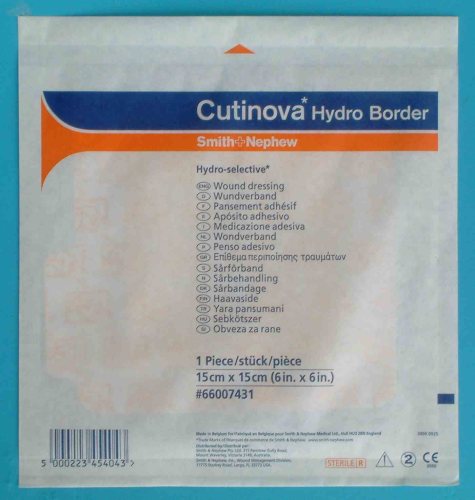
| Product Name: | Cutinova Hydro Border |
| Classification Name: | Polyurethane adhesive dressing with superabsorbent |
| Manufacturer: | Smith & Nephew Healthcare Ltd |
Cutinova Hydro Border is an absorbent self-adhesive island dressing.

The dressing, which is about 2 mm thick, consists of a hydrophilic polyurethane matrix containing particles of a polyacrylate superabsorbent, bonded to the centre of a semipermeable polyurethane membrane leaving a 2 cm adhesive border. The membrane acts as a carrier for the foam and provides an effective bacterial barrier.
The superabsorbent particles within the foam absorb exudate to form a gel, which is not released from the foam but retained within its structure, leaving no residue upon the wound surface following removal of the dressing.
The superabsorbent preferentially absorbs the aqueous component of exudate, effectively increasing the concentration of enzymes, growth factors and other proteins in the exudate that remains within the wound.
Cutinova Hydro Border swells as it absorbs liquid; eventually taking up the contours of the wound and the affinity of the superabsorbent for water is such that it is retained by the dressing even when subjected to pressure.
Cutinova Hydro Border is indicated for use on most types of exuding wounds, but is most suited to low-to-moderately exuding wounds. It can be used on leg ulcers, pressure sores, diabetic foot ulcers and superficial and partial thickness burns.
Cutinova Hydro Border is contra-indicated for full thickness wounds with exposed muscle, bone or tendon or dry wounds such as those covered with black necrotic eschar. The dressing should also not be applied to wounds surrounded by fragile skin.
Clean the wound in accordance with local procedures and ensure that the surrounding skin is clean and dry. Wherever possible a dressing should be selected that is large enough to ensure that the central pad overlaps the wound edges by approximately 2 cm. Remove the protective layer that covers the wound contact surface and place the dressing in position. Remove the carrier from the outer surface of the dressing and gently smooth into place paying particular attention to the adhesive border. No secondary dressings are required.
The frequency of dressing changes depends upon the condition of the wound and the amount of exudate produced. During the initial cleaning phase the dressing may require changing every 1-3 days but subsequently the intervals between changes can be extended to up to 7 days. The formation of a pronounced white blister or bubble, visible through the back of the dressing, indicates that it needs replacing.
Cutinova Hydro Border should not be used with solutions of hypochlorites or peroxides as these will chemically degrade the product.
Cutinova Hydro Border is presented in a paper peel pouch, sterilised by gamma irradiation.
Cutinova Hydro Border is available in the following sizes;
10cm ×11cm*
15cm ×15cm*
17cm ×20cm*
* Available on Drug Tariff
1. Achterberg, V., Meyer-Ingold, W. Hydroactive dressings and serum proteins: an in vitro study. Journal of Wound Care 1996; 5(2): 79-82.
Further information on obtaining Smith &Nephew products is available on the Smith &Nephew web site.
| Revision Author | Dr S. Thomas |
| Revision No | 1.5 |
| Revision date | 2004/02/13 |
This datacard has been prepared from data provided by the manufacturer and/or from published literature.